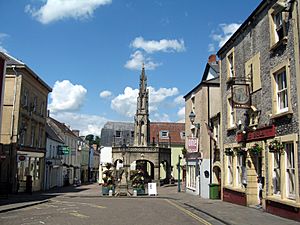Hugh Inge facts for kids
Hugh Inge (born around 1460 – died August 3, 1528) was an important English leader in Ireland during the 1500s. He served as a top religious leader, first as the Bishop of Meath and then as the Archbishop of Dublin. He also held a powerful government job as the Lord Chancellor of Ireland.
Early Life and Education
Hugh Inge was born in a town called Shepton Mallet in Somerset, England, around the year 1460. Not much is known about his family. However, it is believed that his parents wanted him to work for the Church from a young age.
He went to Winchester College for his schooling. Later, he became a fellow at New College, Oxford in 1484. He earned his first degree in 1491 and a higher degree in 1511. In 1491, he became a priest. He held several smaller Church jobs in England.
After traveling around Europe, he joined the household of Adriano Castellesi, who was a bishop from Italy. Inge went with him to Rome in 1504. In Rome, he managed the English hospice, which was a place that offered help and shelter to travelers. He held this job until 1508.
Around 1511, a very powerful man named Cardinal Wolsey noticed Hugh Inge. Wolsey was impressed by Inge's skills and helped him advance his career. Inge later said that he owed everything he achieved to Wolsey. He felt that "without him I had no comfort in this world."

Working in Ireland
In 1512, thanks to Cardinal Wolsey's help, Hugh Inge became the Bishop of Meath in Ireland. There was a brief disagreement between Inge and Wolsey. In 1514, Inge wrote to Wolsey, asking him not to "cast him away." The problem seemed to be that Wolsey wanted Inge to give up another Church job he held to the King's doctor.
The disagreement did not last long. With Wolsey's continued support, Inge's career grew. He followed in the footsteps of William Rokeby, taking over both the role of Archbishop of Dublin and Lord Chancellor of Ireland in 1521. He also joined the Privy Council, a group of important advisors to the King. This was done to strengthen the "English party" within the Council.
Hugh Inge was well-liked and respected in Ireland. He was friends with Gerald FitzGerald, 9th Earl of Kildare, who was a very powerful political figure in Ireland for many years. Inge often wrote to Wolsey, explaining that a big problem for the government in Dublin was the lack of money.
Protecting Church Property
Archbishop Inge worked hard to repair the Archbishop's main home in Dublin, called the episcopal palace of St. Sepulchre. His name is remembered through "Hugh Inge's door." This door was fixed up in the 1700s. Some parts of the original door were found during digs at present-day Kevin Street. The door was known for its unusual three-pointed top.
Inge was very careful to protect the rights and properties of the Archdiocese of Dublin. In 1524, he complained to the Privy Council of Ireland that the city leaders of Dublin had illegally taken over the Manor of St. Sepulchre. This manor was a special area under the Archbishop's control.
The Council sent the matter to three top judges. They decided that the land did belong to the Archbishop. They ruled that he and future Archbishops had the right to keep it forever, without interference from the Mayor of Dublin.
Death and Legacy
In 1528, a serious outbreak of a mysterious illness called the sweating sickness spread across England, Ireland, and parts of Europe. Hugh Inge was one of the people who caught the disease. He died on August 3, 1528. He was buried in St. Patrick's Cathedral, Dublin.
Historians have praised Hugh Inge. They describe him as an honest judge who was fair and wanted to do what was right. Even though not many of his legal decisions were written down, they were considered very important. During his lifetime, a writer named Polydore Vergil called him an honest man. He said Inge helped bring order and good government to a difficult kingdom.
| Catholic Church titles | ||
|---|---|---|
| Preceded by William Rokeby |
Archbishop of Dublin 1523–1528 |
Succeeded by John Alen |

